Related Research Articles

The Eiteljorg Museum of American Indians and Western Art is an art museum in downtown Indianapolis, Indiana, United States. The Eiteljorg houses an extensive collection of visual arts by indigenous peoples of the Americas as well as Western American paintings and sculptures collected by businessman and philanthropist Harrison Eiteljorg (1903–1997). The museum houses one of the finest collections of Native contemporary art in the world.
Jaune Quick-to-See Smith is a Native American visual artist and curator. She is an enrolled member of the Confederated Salish and Kootenai Tribes and is also of Métis and Shoshone descent. She is an educator, storyteller, art advocate, and political activist. Over the course of her five-decade long career, Smith has gained a reputation for her prolific work, being featured in over 90 solo exhibitions, curating over 30 exhibitions, and lecturing at approximately 200 museums, universities, and conferences. Her work draws from a Native worldview and comments on American Indian identity, histories of oppression, and environmental issues.
Teri Greeves is a Native American beadwork artist, living in Santa Fe, New Mexico. She is enrolled in the Kiowa Indian Tribe of Oklahoma.
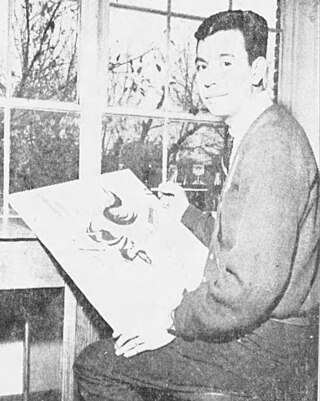
Arthur Douglas Amiotte is an Oglala Lakota Native American painter, collage artist, educator, and author.
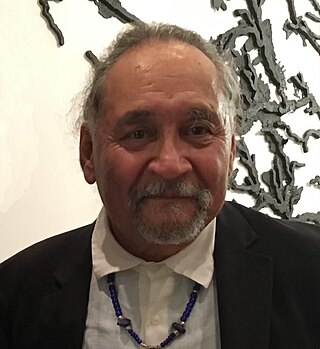
Jim Denomie was an Ojibwe Native American painter, known for his colorful, at times comical, looks at United States history and Indigenous peoples of the Americas.
America Meredith is a painter, curator, educator, and editor of First American Art Magazine. America Meredith is an artist and comes from a Swedish-Cherokee background who blends pop imagery from her childhood with European and Native American styles.
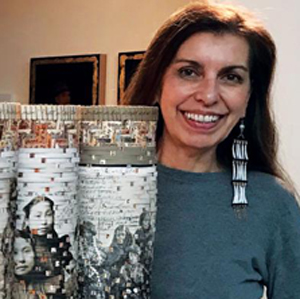
Shan Goshorn was an Eastern Band Cherokee artist, who lived in Tulsa, Oklahoma. Her interdisciplinary artwork expresses human rights issues, especially those that affect Native American people today. Goshorn used different media to convey her message, including woven paper baskets, silversmithing, painting, and photography. She is best known for her baskets with Cherokee designs woven with archival paper reproductions of documents, maps, treaties, photographs and other materials that convey both the challenges and triumphs that Native Americans have experienced in the past and are still experiencing today.

Norma Howard is a Choctaw-Chickasaw Native American artist from Stigler, Oklahoma, who paints genre scenes of children playing, women working in fields, and other images inspired by family stories and Choctaw life. Howard won her first art award at the 1995 Red Earth Native American Cultural Festival in Oklahoma City. Her work is popular with collectors and critics.

Ramona Sakiestewa is a contemporary Hopi Native American artist who lives and works in Santa Fe, New Mexico. Sakiestewa is renowned for her tapestries, works on paper, public art, and architectural installations.
Andrea Carlson is a mixed-media American visual artist currently based in Chicago. She also maintains a studio space and has a strong artistic presence in Minneapolis–Saint Paul, Minnesota.
Cara Romero is an American photographer known for her digital photography that examines Indigenous life through a contemporary lens. She lives in both Santa Fe, NM and the Mojave Desert. She is an enrolled citizen of the Chemehuevi Indian Tribe.
Zoë Marieh Urness is a photographer of Alaskan Tlingit and Cherokee Native American heritage. She creates portraits of modern Indigenous cultures in traditional regalia and settings.
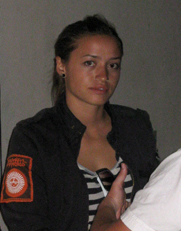
Rose B. Simpson is a mixed-media artist who works in ceramic, metal, fashion, painting, music, performance, and installation. She lives and works in Santa Clara Pueblo, New Mexico. Her work has been exhibited at SITE Santa Fe ; the Heard Museum ; the Museum of Contemporary Native Art, Santa Fe (2010); the National Museum of the American Indian, Smithsonian (2008); the Denver Art Museum; Pomona College Museum of Art (2016); Ford Foundation Gallery (2019); The Wheelwright Museum of the American Indian (2017); the Minneapolis Institute of Art (2019); the Savannah College of Art and Design (2020); the Nevada Museum of Art (2021); Whitney Museum of American Art, and the Norton Museum of Art (2024).
Athena LaTocha is an American artist based in New York artist. Her mixed-media works focus on humans' relationships to natural landscapes. She is of Hunkpapa Lakota and Ojibwe descent.
Julie Buffalohead is a contemporary Indigenous American artist. Her work mainly focuses on themes of racial injustice, indigenous rights, and abuse of power.
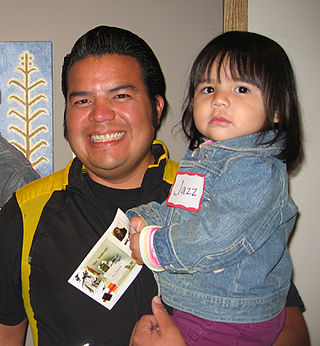
Jason Garcia is a contemporary Native American artist in the United States, who was born in Santa Clara, New Mexico. His work has been exhibited the Smithsonian in Washington D.C, the Heard Museum in Phoenix, the Palm Springs Art Museum, and many more. He won the 2018 Mentor Fellowship Award under the Native Arts and Cultures Foundation amongst many others.
Margaret E. Jacobs is a Native American artist and member of the Akwesasne Mohawk tribe, known for her sculptures, jewelry, and sketching. She draws inspiration from her culture and upbringing. She values natural and synthetic objects and is inspired by buildings in the United States; they are a reminder of Mohawk ironworkers who left their tribes and communities to help build structures. Most of Jacobs' work has been based on the history of the Mohawks, her cultural heritage, and stories.
Melissa Melero-Moose is a Northern Paiute/Modoc mixed-media artist and co-founder of Great Basin Native Artists, a collective based in Nevada. She is enrolled in the Paiute-Shoshone Tribe of the Fallon Reservation and Colony.
Delina White is a contemporary Native American artist specializing in indigenous, gender-fluid clothing for the LGBTQ and Two-Spirit Native communities. She is also an activist for issues such as environmental crisis, violence against women, and sex trafficking.
References
- ↑ "Dyani White Hawk - Native Arts and Cultures Foundation". Native Arts and Cultures Foundation. 21 October 2015. Retrieved 2016-03-05.
- ↑ "Ace gallery director Dyani White Hawk Polk resigns AMRG post". Star Tribune. Retrieved 2016-03-05.
- ↑ "Dyani White Hawk Polk". First Peoples Fund. Retrieved 2020-05-12.
- ↑ "MacArthur Fellows - MacArthur Foundation". www.macfound.org. Retrieved 2023-10-05.
- ↑ "Three Minnesotans announced as Guggenheim Fellows". MPR News. 2024-04-11. Retrieved 2024-04-16.
- ↑ "Dyani White Hawk - Cowboys and Indians Magazine". Cowboys and Indians Magazine. 17 December 2015. Retrieved 2016-03-05.
- ↑ "Dyani White Hawk". Elmhurst Art Museum. Archived from the original on 2017-01-17. Retrieved 2016-03-05.
- ↑ White Hawk Polk, Dyani (April 24, 2014). "Dyani White Hawk Polk Interview". Native Report (Interview). Interviewed by Stacey Thunder. Duluth: WDSE/WRPT PBS.
- ↑ "Painting - dyani white hawk".
- ↑ Hopkins, Candice. "Dyani White Hawk." McKnight Foundation Fellowship for Visual Artists, 2014-2015.
- ↑ "Last picture show for McKnight Foundation". startribune.com. Star Tribune. January 16, 2014. Retrieved 5 January 2016.
- ↑ Leaken, text by Suzanne Deats; principal photography by Kitty; Leaken, Kitty (2012). Contemporary Native American artists (First ed.). Salt Lake City: Gibbs Smith. ISBN 978-1423605591.
{{cite book}}: CS1 maint: multiple names: authors list (link) - ↑ "Bockley Gallery :: Artists :: Dyani White Hawk". bockleygallery.com. Retrieved 2016-03-05.
- ↑ "Untitled (Quiet Strength I), Dyani White Hawk ^ Minneapolis Institute of Art". collections.artsmia.org. Retrieved 2019-11-09.
- ↑ "Dyani White Hawk". Elmhurst Art Museum. Archived from the original on 2017-01-17. Retrieved 2016-03-05.
- ↑ "Dyani White Hawk - Cowboys and Indians Magazine". Cowboys and Indians Magazine. 17 December 2015. Retrieved 2016-03-05.
- ↑ "Swaia - Indian Market: About SWAIA/SWAIA Fellowships/2012 SWAIA Fellowship Recipients". swaia.org. Retrieved 2016-03-05.
- ↑ "Last picture show for McKnight Foundation". Star Tribune. Retrieved 2016-03-05.
- ↑ "Dyani White Hawk: Speaking to Relatives". Kemper Museum of Contemporary Art. 2020-11-10. Retrieved 2021-04-14.
- ↑ "Dyani White Hawk". Highpoint Center for Printmaking. 20 October 2020. Retrieved 2021-04-14.
- ↑ Foundation, Joan Mitchell (17 December 2014). "Joan Mitchell Foundation » News & Events » Joan Mitchell Foundation announces the 2014 Painters & Sculptors Grant Recipients". joanmitchellfoundation.org. Retrieved 2016-03-05.
- ↑ "Realizing the Potential of Creative Vision". Native Arts and Culture Organization. Retrieved 5 March 2016.
- ↑ "Dyani White Hawk". Highpoint Center for Printmaking. Retrieved 2020-05-12.
- ↑ "Whitney Biennial 2022: Dyani Whitehawk". Whitney Museum of American Art. Retrieved 2022-11-02.
- ↑ "Beauty Is Medicinal: Dyani White Hawk on her Whitney Biennial Artwork". Bockley Gallery. 6 October 2022. Retrieved 2022-11-02.
- ↑ Ahlberg Yohe, Jill; Greeves, Teri (2019). Hearts of Our People: Native Women Artists. Minneapolis, MN: Minneapolis Institute of Art. ISBN 9780295745794.
- ↑ "Indelible Ink: Native Women, Printmaking, Collaboration – UNM Art Museum" . Retrieved 2021-03-31.